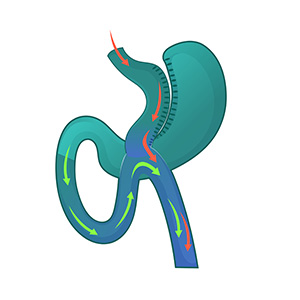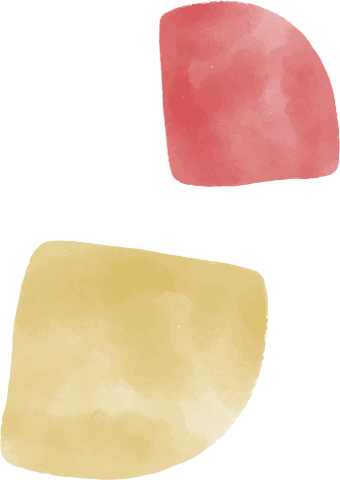Mini Gastric Bypass
All these names refer to the same basic operation. Anastamosis means join.

Surgery
Surgery is performed under General Anaesthesia using laparoscopic (keyhole) techniques through 5 small incisions in the abdomen.
The stomach is divided into a long thin pouch, and then a loop of bowel is brought up and joined to it. Digestive juices travel without food to act on until they come to the loop up at the stomach. Food digestion only happens in the lower part of the small intestine. The surgery is simpler and safer than the Roux en Y but the incisions are the same. A potential disadvantage is that if ‘reflux’ occurs it will contain some digestive juices that can damage the oesophagus. It is therefore not ideal for patients with severe reflux, nor for smokers. Around 1 in 50 patients will need follow-up surgery for reflux.
This surgery is increasingly performed as it has less problems of obstruction and acid reflux than a sleeve, with more powerful weight loss and diabetes control. Like all bypass procedures, there is a need to take multivitamins long term and to have blood tests a few times per year.
This is the operation of choice for non-smokers with Diabetes or a BMI more than 45.


How does weight loss occur with Gastric Bypass?
The most important way weight loss occurs is through a substantial and prolonged decrease in appetite. There are powerful hormones produced when food is diverted away from the first part of the small bowel and delivered into the lower small bowel. These hormones are powerful suppressors of the appetite and also counteract insulin resistance associated with type 2 diabetes. Meal sizes are reduced by the small pouch of stomach.
Prior to Surgery
You will need to be on an ‘Ultra-low Calorie Diet’ before surgery. Optifast is taken for 2 weeks to replace ALL meals. If you feel you MUST have something else, then it needs to contain very few calories. (Salad or steamed vegetables without dressings or oil for a ‘treat’). Check with the nutritionist.
The usual stay in hospital is 2 post-operative nights.
Following Surgery
Day 1-4: Fluids that could be sucked through a thin straw.
Day 4-7 : thick fluids progressing to puree.
Week 2: Soft food like mash or scrambled eggs.
Week 3+: Gradual introduction of chewable food. Make sure you get enough protein.
Potential complications of Gastric Bypass
This is a rare complication that can occur early on. It is a failure of surgery or staples (rare) or a failure of healing. Leaks can occur at the join or on the staple line itself. Managing a leak may require further procedures, or even surgery, to get it fully healed.
This is an erosion that occurs near the stomach join that can cause bleeds, narrowing or perforation. It is a problem mainly in smokers. It may mean taking anti-acid tablets, or occasionally further surgery.
This is usually experienced as Heart Burn. Reflux after a Single Anastamosis Gastric Bypass is rare (as opposed to Sleeve Gastrectomy), but when it happens it can be severe, and 1/50 will need conversion to a Roux-en-Y Gastric Bypass.
A rare complication of weight-loss surgery is persistent nausea or vomiting. The problem is usually investigated (and fixed) by endoscopy and balloon, but further surgery could be required if there is a physical problem such as a narrowing that does not respond.
While we are aiming to have less calories consumed, sometimes vitamins, protein, or minerals are not absorbed well. Multivitamin supplements will usually suffice, but we do check on blood tests at least three times per year for the first year or so to make sure things are stable.
These include but are not limited to the following which are similar for almost any abdominal surgery.
-
Wound infection
-
Bowel adhesions
-
Bleeding
-
Clots
-
Pneumonia
-
Heart trouble
-
Hernia


General Advice after Mini Gastric Bypass
- Vomiting
- Vitamins
- Pregnancy
- Medication
- Nutritional issues and 'Dumping'
- Appointments
Vomiting
Patients may vomit or feel pain after food intake. This can be can be caused by swallowing too quickly, trapping air, or un-chewed chunks of food getting stuck. By eating slowly and calmly, you will learn to listen to the signals from your stomach. Notify Dr Crawford if new or persisting vomiting develops after you are home.
Vitamins
The bypass causes a reduction of absorption of some elements and vitamins. A chew-able or liquid vitamin mixture containing multivitamins, in particular the vitamin B complex, is recommended following surgery. Your nutritionist will give you advice around vitamins. You will need lab tests every few months to monitor your levels.
Pregnancy
The period between surgery and weight stabilisation is considered to be a period of starvation. It is not advisable to become pregnant during starvation, despite the fact that the foetus has priority over the mother with regard to food. Should you nevertheless get pregnant, it is advisable to let Dr Crawford and your nutritionist know. Wait 9-12 months before trying to become pregnant.
Medication
Tablets must be broken down into small pieces or crushed before they are taken. It is common that medication for conditions such as hypertension, diabetes or asthma may need to be altered (reduced) after the operation. You should consult your local doctor about this.
Dumping
Dumping syndrome is discomfort or dizziness associated with eating that can usually be managed by changing how you eat. Your nutritionist will give you advice should you require it.
Appointments
You should see your dietician one or two weeks after surgery, and Dr Crawford after 4-5 weeks. Dr Crawford will usually need to see you again once or twice in the next few months before an annual review. You will need to get blood tests 3 times per year for the first couple of years.
Physical activity
It will be important to alter not only your eating habits, but also your level of physical activity. You should start exercising slowly after surgery. As weight loss is achieved, physical activities will gradually become easier.
Long-term follow up and lifestyle
In order to get the best results from your surgery, it is important that you are committed to long term changes. Regular consultations are necessary to review your progress, monitor your weight and health, advise you on diet and exercise and look for any long-term problems.
Your commitment to dietary and lifestyle changes is essential to ensure the success of your surgery. In the long term you should eat small healthy meals and drink only liquids containing little or no calories such as water, tea, coffee and sugarless drinks.
Regular exercise should be a part of your weight loss program and you should aim to exercise for at least 20 to 30 minutes every day.


